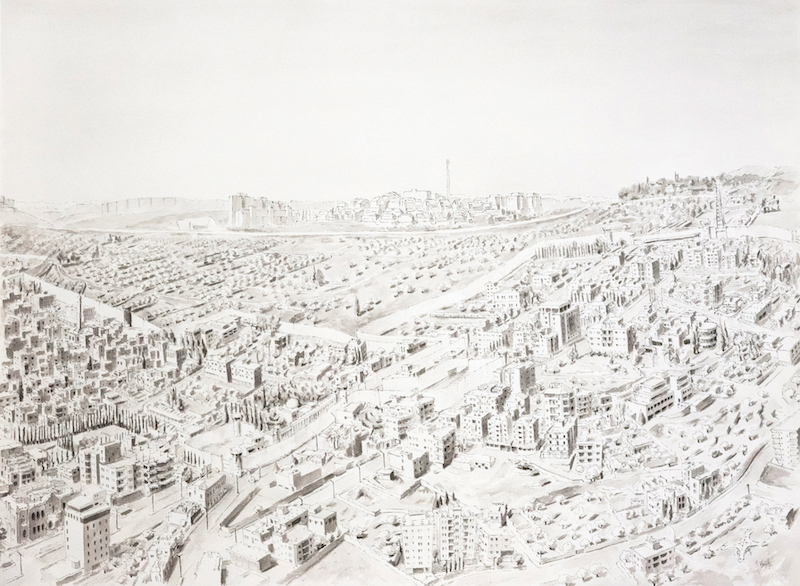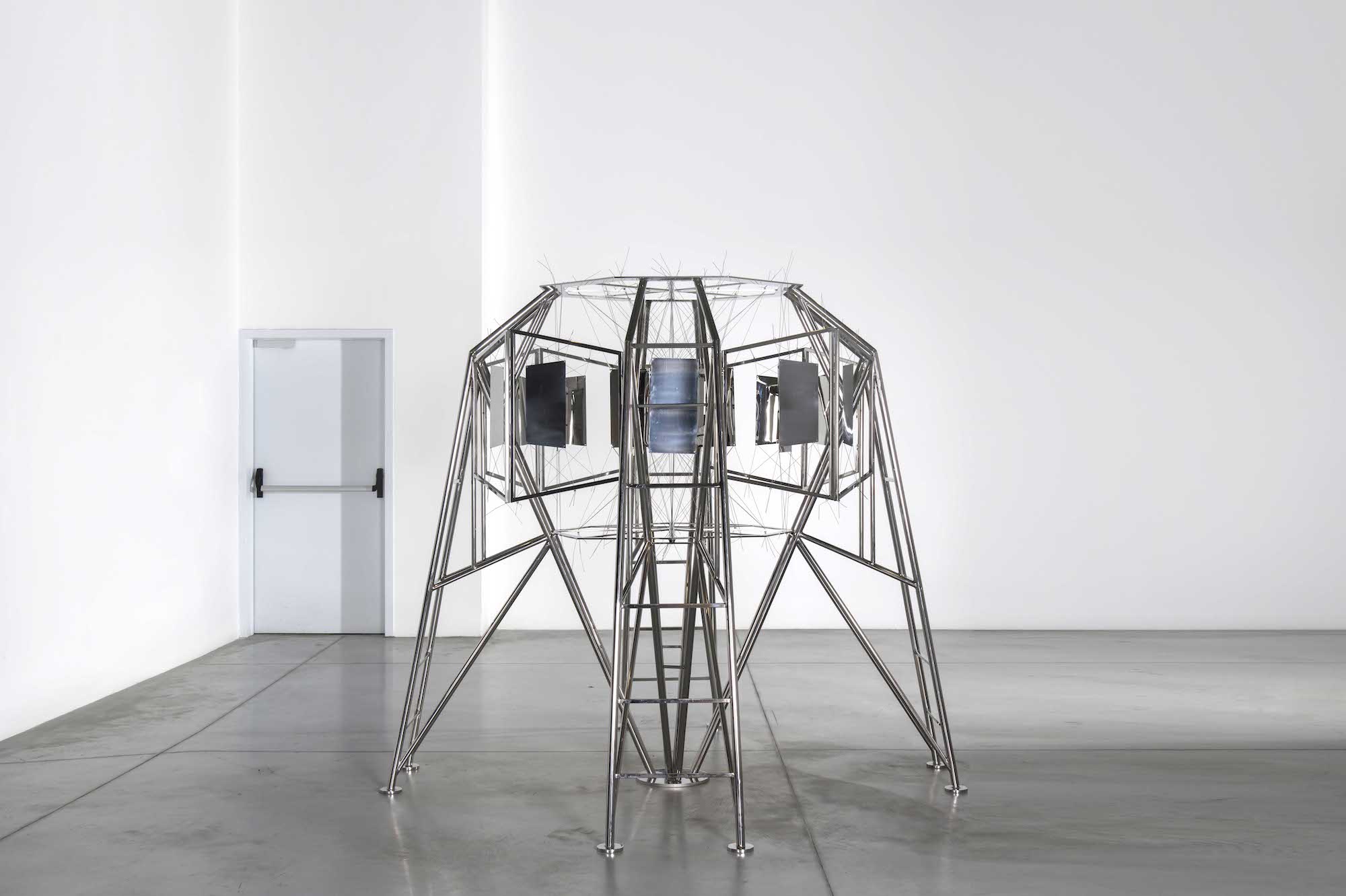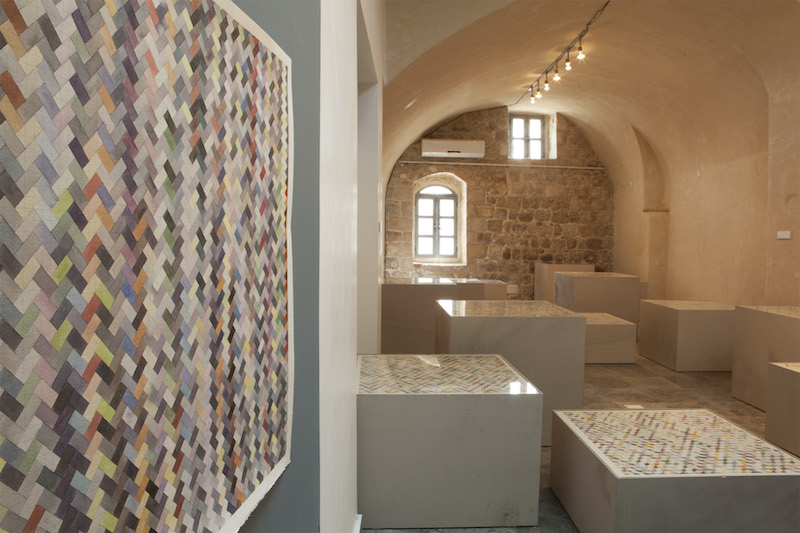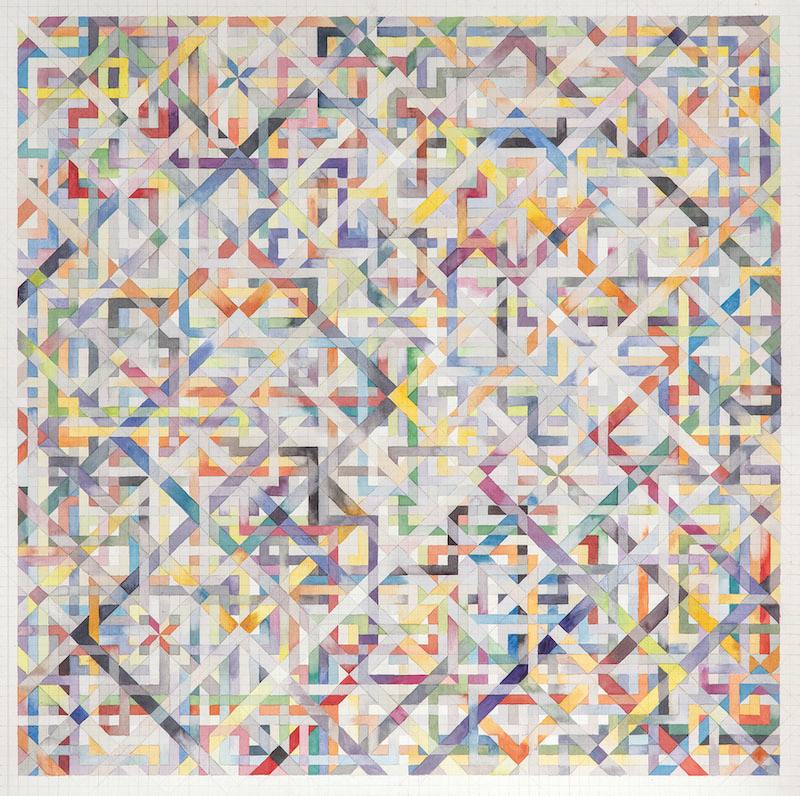The first part of this interview was originally published under the title “Reverberations of a Pandemic” on the website of Villa Romana, Florence.
Benji, your artistic work centres on observations of the interaction of bodies and space, of building structures and infrastructures and you investigate all these materials as an archive. In 2015 with Phantasmagoria of Drones you mapped in great detail the urban fabric of Bethlehem including the separation wall, roads, checkpoints, refugee camps etc. What are the new layers of control and restriction that have now additionally been physically inscribed in this landscape with the Corona pandemic?
I was actually thinking about the drawing when the curfew began, it felt premonitory, but not for the reasons one could have imagined. The drawing depicts the entrance of Bethlehem devoid of people, activities and closed borders, fitting the times of the pandemic pretty accurately. This scenery is not unfamiliar to the memory of this place, because of Israeli military curfews imposed in times of high tension. Lockdown /occupation analogies have come up quite frequently in social media platforms since the pandemic began, but those are totally different circumstances, and this analogy downplays the nature of the occupation, which is not a state of exception but rather a permanence. Since I did the drawing in 2015, some small changes have happened, a few new buildings were erected, and the neighbourhood blossomed into the epicentre of occupation tourism. I probably would not have thought of doing this drawing had I not been commissioned to imagine a subjective map of this place. I find the use of images of the Wall conflicting, because it has the potential to assert itself in the imaginary of this place, to commodify it and normalize it. Contrary to the incentive of shedding light onto a situation, it seems to shine a light onto it. Inadvertently but predictably, the wall becomes a monument of the 21st century, commemorating our times and the perpetual present events we live through. A monument understood as an idea that stems from hegemonic structures to remind us of something. In the process of elaborating this work, I noticed that views from above of this area are not accessible to the public and you cannot fly a drone because it is a politically sensitive area: Basically, this image did not exist. In that respect, I thought the only thing that made sense was a map that attempts to show realistically the different layers of the landscape and the Wall being another trace, a sense of looking at the distant past of a present that unfortunately is here to stay.
Bethlehem was the first city to go under lockdown in early March; a couple of weeks ago those orders were relaxed. The Israeli checkpoint re-opened, but with tougher crossing restrictions, a few hundred metres apart, a mobile Palestinian Authority patrol car sifts those who enter through the checkpoint, an ironic momentary reversal of roles considering the context at large. Life is slowly getting back on course, but tourists are absent and not about to come back. It will be quiet in this open-air museum whose image overshadows the hopes of people dreaming of a better life and equality.

I want to quote Indian novelist Arundhati Roy who, in a long text on the situation in India, published recently in the Financial Times, noted “The lockdown worked like a chemical experiment that suddenly illuminated hidden things . . .as the wealthy and the middle classes enclosed themselves in gated colonies, our towns and megacities began to extrude their working-class citizens—their migrant workers—like so much unwanted accrual.” I think her observation can be adapted to most societies right now. What did you observe?
It is difficult to paint a general picture of the situation here, because of the social complexities, the territorial fragmentation, etc… Regarding the occupation, the colonial steamroller is in full swing. Control of mobility is already set up, aided by an array of tools. The territory is designed to potentially lock down neighbourhoods and cities. This situation is all very well documented, to the extent that it feels like we have reached a tautological impasse. With the pandemic the gates shut, unexpected ones too, and unexpected ones opened. When the lockdown started, Israel called on the Palestinian labour force to cross the border and stay there, something unheard of, but logical in terms of the economic dynamics of colonial exploitation. Some workers cross illegally through breaches, others legally through checkpoints; the lure of working in Israel is financial, as salaries and opportunities are better. There was this story about Palestinians reporting to the Israelis breaches in fences that workers use to cross back and forth to Israel, but they were lenient in closing them. This is another example of an ironic reversal of the imaginary, only temporarily. As Israel was reaching its peak and the lockdown got stricter, a lot of workers returned to the Palestinian cities and villages. This created all kinds of fears based on the idea that they would bring back the virus. The first reported death in Palestine was a consequence of this situation, and there are other cases of spreads related to this.
As I mentioned earlier, Bethlehem was the first city to go under lockdown, because it is a tourist attraction. It is a small agglomeration, made up of a few municipalities and some refugee camps, and sealed on all sides by the Wall and settlements. The northern municipalities are wealthier, but in general the population is socially mixed and the social structure is to a large extent family or clan based. Apart from the refugee camps and historic centres that have their own identity, the urban fabric is heterogeneous. There are no gated communities as such but upper-class villas, pockets of wealthier compounds and luxury residencies scattered around. What struck me in the beginning was a wave of xenophobia, because the foreigner brought the virus. Prices on Italian pasta dropped. The first few weeks the atmosphere was eerie, the streets were nearly empty, many of them were blocked, stone boulders were named road-blocks of peace. Different agencies of the PA forces were all over, essentially controlling the movement between neighbourhoods, saving the population from the virus through the resour-ces invested in security. The fact that very few cases were reported made people more relaxed, especially as Ramadan started and continued, as it is social holiday. One could see more people in the streets and questionable corona distancing. Except for an event where the Israeli army took advantage of the lockdown to raid a camp and arrest people, the political atmosphere in Bethlehem was quiet. There were also a couple of confrontations with the PA regarding the return of workers for the Eid al-Fitr, the holiday that marks the end of Ramadan, a four day curfew was imposed, which ended up with an anti-lockdown incident at the entrance of a refugee camp that resulted in some heavy gunfire and few injuries. There was also an anti-lockdown clash midway through Ramadan, tyres were burned at a junction, and riot police intervened. But the general atmosphere is the anxiety of economic hardship. To sum up the lockdown, it started with fear of the foreigner, and then moved to the fear of poverty.
The question of class displayed itself on all sides, like all over the world, the virus revealed broken systems. As class identification has been altered by national or ethnic identification, it plays a role in the political imaginary of the occupation in terms of the way we identify the protagonists. Class is not a topic that is much talked about, apart from the logical association of capitalism and colonialism, hence the Palestinians are imagined as the poor, which is not false, but the lack of class discourse shapes generalizations in the collective subconscious. Both societies are far from being socially and economically homogenous. To make matters worse, since it was instated in the nineties the PA has been coerced by the donor countries to create a market economy, this, combined with their security obligations, makes them actors in maintaining economic peace, hence the status quo, or, the management of the occupation.
If we take the art world and look at the imaginary of the occupation, it is not very different. Decolonisation discourses occupy a hegemonic space, they present a set of legitimate critiques, but they also have their limits. There is what Arundhati Roy highlights, an underlying problem of class that is not being addressed. Their methodology follows a top down approach and leaves any form of social science to be desired. The attention shifts to the representation of the consequences of the situation, or dystopic imagery mirroring its subject of criticism. Rather than reflecting on the source and causes of the problem, it is an imaginary that reiterates the condition of the dominated and, by corollary, maintains a form of alienation that is the goal of colonisation: the prevention of emancipation.
Your work Reverberation, aka The Spaceship (as I read on your FB page) has been presented recently at the Istanbul Modern. The two titles of this work leave room for interpretation. The Spaceship has both a scientific and utopian connotation. Could you talk a bit about this science fiction /utopian moment in your work? I am even more curious about the title Reverberation – reverberation of what?
The notion of utopia has been in my mind since my architectural studies, the idea of imagining an alternative is compelling. Those utopias shaped the fictions of the 20th century and beyond, like sci-fi. The sci-fi moment as a tangible reference in my work happened during the Armenian Triennial in 2017. When I was doing my research trip, Soviet and prehistoric traces fascinated me, bus stations that looked like spaceships and prehistoric caves turned into ritual sanctuaries. I decided to work with steel because I was looking for some reflective surfaces, and the imaginary of this material is interesting, both as one of the mediums that designed all those utopian fantasies, but also in terms of its historical significance. It is hybrids of associations that I extract from the archives of the imaginary.
Utopias, or alternative fictions is one way to deal with the lack of distance that we have from the current political events and their temporality, especially when the event prolongs into something that feels permanent. I look for different ways to evoke present day preoccupations, alternative fiction can be a way to reflect on the cause of those preoccupations, and utopia a way to imagine a better world.

The title Reverberation refers to the echoes of collective subconscious emotions or the phantom phantasmagorias. Being partly of Armenian descent and doing a work in Istanbul is not anodyne. My surname stimulates projections and expectations, whether I like it or not, and they emanate from different sides. The only approach I felt I could have was to question my agency in those circumstances, to live the absurd and do something in the process of it. So, I decided to land a spaceship in Istanbul. I had in mind to make an interactive sculpture that would function as a mise en abimes device, a space that put bodies in interaction with one another and their images, using a system of mirrors. The form came at later stages of the process. During that time I visited Hrant Dink’s memorial and read his book. What struck me was his outspoken anti-racism and claim for equality, and the way the memorial detaches itself from the image of the victim, from the condition of the dominated. From the perspective of the historical loser, equality is a tricky claim. That is where utopia comes in, because it is time to imagine real alternatives, a better world.
Documenting to preserve is an aspect of your work that particularly strikes me. Especially the long processes you are going through in documenting call for patience and perseverance – I am thinking of the water color drawings of The Temporary Ruin (2014) and The Discord (2016). The Discord (2016) is a series of drawings based on industrially produced cement tiles, an invention of modernity that has spread throughout the Mediterranean in the early 20th century. In a recently published book on this work, curator and writer Jonatan Habib Engqvist points to similarities with American artist Agnes Martin. Even though The Discord opens up many references, I am also touched by a transcendental moment in what I want to call an artistic meditation and a stretching of time. Do you see parallels to Agnes Martin yourself?
Before reading Jonatans text, Agnes Martin didn’t really cross my mind, although Abstract Expressionism is something that also influenced this work. When I was a student, I did a semester in San Francisco, I had learned about the Jeffersonian grid before that trip, but experiencing and practicing a city like san Francisco and seeing the grid from a plane was a telling experience, the contrast between the man made and morphology of nature was so stark, I can understand why Martin refers to the grid as expression of innocence. For me the grid is the contradiction of an underlying structure, something rigid and an ex-nihilo space, a space of possibilities. Thinking about it, the parallel I can see with Martins work is a whim for repetition, the slow and evolving process of making, observing and thinking about the same thing. Maybe to reach something, and in the case of abstractness and tessellations, this thing might be a sense of a transcendental moment which is one of the qualities of these paradigms.


I would like to return to the subject of material and materiality. We have already talked about tiles, steel and also ruins. The critical attempt to understand the modernist narratives of progress, how and where their power and material effects are located, seems to me to be present in almost all of your works? How is one material history erasing others? Matter, material and material ecologies are also at the centre of discussions on the antropocene…
Can you dissociate something from its memory? reduce it to dust? Even particles contain physical properties with factual information and those can be a source for speculations. As long as there are humans around, matter will absorb memory. If we look at the recent ‘Black Lives Matter’ events and the corollary destruction, dismantling and removal of confederate monuments and other figures with racist pasts, it shows an ineluctable relation between matter and memory.
Maybe it’s because of my educational background in architecture that materiality presents itself in an overarching way in my work. Architecture is by excellence the field for materialist psychoanalysis. It started off as a functional solution for a practical problem, and has evolved into something that encompasses everything related to space, from physical matter to political imaginary. As the Architects joke goes, ‘the engineer knows everything about nothing, the architect knows nothing about everything.’
Materiality is one aspect I take it into consideration in my work, whenever I am working on an idea or with a medium, I question the materiality of it. It comprises everything from the physical properties of matter to its human appropriations and interactions. This notion sheds a light on the complex relationship of humans with their surroundings, especially when dealing with politicized matter, which are magnets to all sorts of projections. I like to think of materiality also through Walter Benjamins notion of phantasmagoria, a critic of the suppression of the practical values, supplanted by the poetic value, in an age where perception changed irreversibly because of modernity. It is through phantasmagoria that the world reproduces itself to us and we perceive the world. Since Benjamins writings our means of production and reproduction have evolved to an extent that its potentialities raise the question on the role of reproduction of images in shaping our belief systems. In the conversations around materiality, some ideas propose objects as autonomous, placing the ‘human’ and ‘non-human’ actants on the same level and suggest an ontological approach to objects. It is not so much the idea of autonomy of objects that preoccupies me, but rather the un-autonomous nature of perception.
Your latest work, which you also present in this online exhibition, is entitled Variations on a map: An Anthology of 31.7683° N, 35.2137° E. Karim Kattan, a Palestinan writer describes the territory of current Palestine as “a set of breadcrumbs”, a description that came to my mind seeing one of the maps you have been creating in watercolor. It is a map that represents a territory that has no coherence and no unity. What kind of maps of Palestine did you chose for the narrative you are telling in your sequence of map drawings? Or let me ask, is this series of maps creating a narrative at all?
I was also wondering about the act of copying. When seeing your drawings for the first time, I tried to figure out, if you are subverting the original maps. You reduce information, but are you also interfering and changing realities? Where would you locate your maps on a scale of objectivity?
I started this work in 2016, now is an opportunity to add some more maps to the collection. Back then I was working with a friend on a piece that revolved around a monument for the Palestinian struggle in Tehran. The allegorical object had a funny detail, there was a silhouette of the map of Palestine in the middle that was unconventionally oriented: upside down. This way of showing the map made me think about the many representations that exist and keep on being produced.
For this work I chose to focus on cartography and started collecting diverse representations of map from a general macro outline. Maps interest me for what they are: from tools of power to the something that belongs to the visual jargon of the ‘ex-habitant’. The work is a simple gesture to create an anthology of maps of this territory. Generally, you do not come across those maps side by side, but on their own, in their context. When you see them together, I think it has the potential to do something. All the maps are taken from the internet, the archive of everything and nothing, the process is like a virtual derive, every time I find a map, I download it, and copy it. I do not change them, I only interfere by duplicating them as miniature watercolors, I omit information by default of the medium and the format, which in turn emphasizes the graphical value. I don’t mention anything about their provenance, because I consider this place as a hyper-signifier, ubiquitous in the political imaginary, and the temporality of the imaginary is not based on any linear reading of time. My intention was not to create any narrative, they already exist, and in the case of this territory, the signified precedes signification. The work is not an attempt to describe the real but rather an attempt to locate the conversation in the domain of the imaginary, by showing the spectrum of political imaginaries projected onto this place.
There are all sorts of maps, some similar and others contradictory, there is a varying degree of fictionality and factuality, I choose whatever I can find, as absurd or random as they get, my only concern is to encompass the whole spectrum. The closest representation of reality is the OCHA (United Nations Office for the Coordination of Humanitarian Affairs) maps, which is an agency of the United Nations, so it is supposedly unbiassed. The problem is that they are unreadable because they literally contain so many graphical layers of information, but in terms of visuals, they look like “a set of breadcrumbs”, and you get a sense of the territorial fragmentation and the complete control of mobility. By collecting all these maps, one can observe a pattern, maps are followed by variations, they don’t necessarily state anything new or have an added value of information, but the graphics and analogies change, there is a sense of repetition, variation and contradiction. One can imagine all kinds sequencings, from logical classifications to arranging them by drawing from the lot. I am more inclined to create different variations of sequences, because, depending on how they are arranged they highlight different things.
Navigate through Benji Boyadgian’s Artist Room
Sumac Space is a venue for raising questions and conversations. It is updated every Thursday with a new, fresh dialogue/text.
Subscribe to the newsletter to be kept up to date.
Agnes Stillger is an art historian and curator, currently based in Florence, Italy. Her research focusses on decolonisation processes, postcolonial networks and material cultures. She is a PhD candidate at the Ludwig-Maximilians-Universität in Munich with a thesis project on the entanglement of art, activism and agriculture in West Africa. In 2019/20 she has been a participant in the workshop series Anthropology and Contemporary Visual Arts from the Black Atlantic, a collaboration of the universities of Dakar, Port-au-Prince and Hannover.